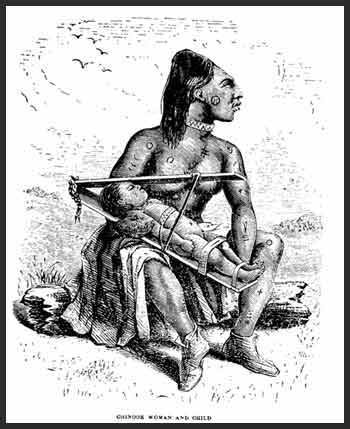Chinookan Head Flattening
“Head of Flat Head Indian on the Columbia. The head broad at top crosswise.”
Drawing by William Clark, about 30 January 1806.
Missouri Historical Society, St. Louis.
Head Flattening
On 19 March 1806, only a few days before leaving Fort Clatsop, Meriwether Lewis took pains to finish his notes on the habits and appearances of the neighborly Clatsop Indians. The most remarkable trait in their physiognomy, he wrote, was the flatness and width of their foreheads, which they artificially created by compressing the heads of their infants, particularly girls, between two boards.
“I have observed the heads of many infants,” he wrote, “after this singular bandage had been dismissed, or about the age of 10 or eleven months, that were not more than two inches thick about the upper edge of the forehead and reather thiner still higher.” The result is a straight line from the top of the head to the end of the nose. This custom, he reported, had been observed among all the Indian nations he had met with west of the Rockies.
These people, he continued, “wear their hair loosly flowing on the back and sholders; both men and women divide it on the center of the crown in front and throw it back behind the ear on each side. they are fond of combs and use them when they can obtain them; and even without the aid of the comb keep their hair in better order than many nations who are in other rispects much more civilized than themselves.”
Kane’s Observations
Caw-Wacham
by Paul Kane (1810–1871)
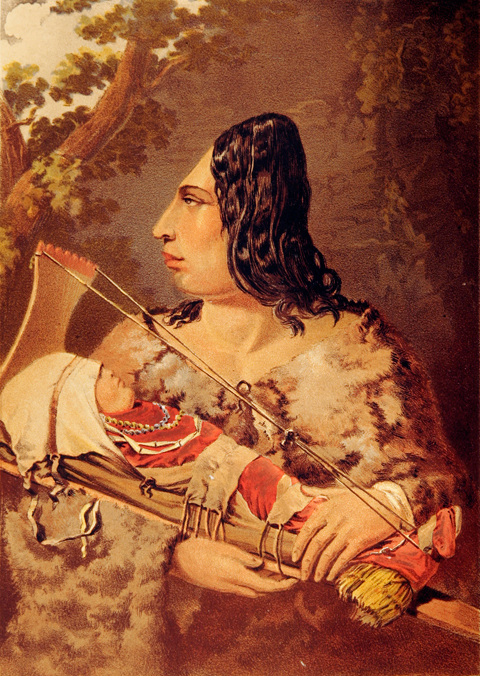
Special Collections, Mansfield Library, The University of Montana, Missoula
On 27 March 1806, five days and, by their estimate, 65 miles into their homeward trip from Fort Clatsop, the Corps of Discovery encountered a group of Salishan-speaking Cowlitz Indians–the captains called them Skillutes–who came along side in their small canoe to trade roots and fish. At midmorning the Americans stopped for breakfast at two Cowlitz houses, where the very hospitable residents gave them dried eulachon, sturgeon, wapato, and camas roots. “Most of the party,” Lewis remarked gratefully, “were served by the natives with as much as they could eat.” The Cowlitz insisted, he continued, “on our remaining all day with them and hunting the Elk and deer which they informed us were very abundant in their neighbourhood.” But the expedition’s hunters who had gone ahead of the main party, had worked the vicinity over without shooting any game at all. Besides, Lewis remarked, it was raining so hard they wouldn’t have been able to dry and caulk their canoes, which would have been their main reason for stopping, so “we declined their friendly invitation, and resumed our voyage at 12 OCk.”
Forty years later, nearly to the day (30 March 1846), the Irish artist Paul Kane (1810–1871) spent a week at the foot of Mount St. Helens, sketching and painting the Indians who lived on the banks of the Cowlitz River. One of the results was the colorful painting below.
“We landed at the Cowlitz farm,” Kane wrote, “which belongs to the Hudson’s Bay Company. Large quantities of wheat are raised at this place. I had a fine view of Mount St. Helen’s throwing up a long column of dark smoke into the clear blue sky. Here I remained until the 5th of April, and took the likeness of Kiscox, the chief of the Cowlitz Indians, a small tribe of about 200. They flatten their heads and speak a language very similar to the Chinooks. They were very friendly to me and I was a good deal amongst them. Sketch No. 10 [above] is Caw-wacham, a woman of the tribe, with her child under the process of having its head flattened. It was with some difficulty that I persuaded her to sit, as she seemed apprehensive that it would be injurious to her.”[1]Paul Kane, Wanderings of an Artist Among the Indians of North America: From Canada to Vancouver’s Island and Oregon through the Hudson’s Bay Company Territory and Back Again (London: … Continue reading
Caw-Wacham was neither Chinookan nor the mother of the child in the painting. Kane painted both separately and likely never posed the two together. Both were Salishan. Caw-Wacham was a visitor to the farm, her home tribe living near the Hudson’s Bay post on Victoria Island. The child was a Cowlitz. The mingling of Middle Salish and Chinookan cultures was representative of the blending that occurred along the Hudson Bay trade route between Fort Vancouver and Fort Victoria in 1846, the time Kane visited.
Swan’s Observations
Beginning in 1852 the ethnographer James G. Swan (1818-1900) lived for three years among the Indians on Willapa Bay–then known as Shoalwater Bay–in southwestern Washington some 25 miles north of the mouth of the Columbia. Swan wrote a brief account of the custom of head-flattening to accompany his sketch of a Chinook woman with her infant.
The most singular custom among these people,” Swan observed, “is that of flattening or compressing the head of the infant. Where this custom originated is hard to tell. Lewis and Clarke state that it is not peculiar to that part of the continent, since it was among the first objects that struck the attention of Columbus. ‘But,’ they add, ‘wherever it began, or what was its origin, the practice is now universal among the tribes west of the Rocky Mountains, in the region of the Columbia, and it is confined to them, for, with the exception of the Snake Indians, who are called Flat-heads, the fashion is not known to the east of that barrier.”
“The method adopted to produce this deformity is as follows: A cradle, like a bread trough, is hollowed out from a piece of cedar, and, according to the taste of the parent, is either fancifully carved, or is as simple in its artistic appearance as a pig’s trough. This cradle, or canim, or canoe, as they term it, is lined inside with the softest of cedar bark, well pounded and cleaned so as to be as soft as wool. On this the infant is placed as soon as it is born, and covered with the softest cloth or skins they can find. A little pillow at one end slightly elevates the head. The child is placed flat on its back, and a cushion of wool or feathers laid on its forehead. An oblong square piece of wood or bark, having one end fastened by strings to the head of the canoe, is now brought down on the cushion, and firmly secured by strings tied to the sides of the cradle, and causing the cushion to press upon the child’s forehead. The infant is then so bound into the cradle that it can not stir hand or foot, and in this position it remains a year or more, only being taken out to be washed and for exercise.”
“This pressure on the forehead causes the head to expand laterally, giving an expression of great broadness to the face; but I never perceived that it affected the mind at all, although it disfigures them very much in appearance. I have seen several whose heads had not been thus pressed, and they were smart, intelligent, and quite good-looking; but they were laughed at by the others, who asserted that their mothers were too lazy to shape their heads properly. This flattening of the head appears to be a sort of mark of royalty or badge of aristocracy, for their slaves are not permitted to treat their children thus; but, although I have seen persons with and others without this deformity, I never could discover any superiority of intellect of one over the other.”[2]James G. Swan, The Northwest Coast; or, Three Years’ Residence in Washington Territory (New York: Harper & Brothers, 1857), 167-68. Internet Archive. A brief biography of this remarkably … Continue reading
Tides of Fashion
If the coastal Indians’ 19th-century criteria of personal beauty strike us as bizarre, or even cruel, we would do well to look at the fads that trend-setters in Western “civilization” have imposed on the same human body.
Bypassing the grotesqueries of 17th- and early 18th-century modes of dress and bodily disfigurement, let us note that the Jeffersonian era was conservative at nearly all levels. Paris society set the fashion in dress, drawing its models from classic Greek and Roman sculpture, much of which had recently been uncovered at Pompeii. Stylish women’s dresses in Lewis and Clark’s day consisted of layers of light-weight garments emphasizing a draped shape, with a high waist, soft bustline, and sometimes a high collar.

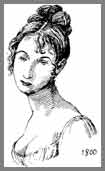
Men on both continents discarded their powdered wigs after the Revolutionary Era and adopted the more natural, classically inspired “Brutus” haircut. Compare the portrait of Meriwether Lewis by Charles B. J. F. de Saint Mémin (1803) with the one painted by Peale (1807), the latter showing him with a haircut in the latest mode.
After 1815, led by changes in French and Austrian precedents, army and navy officers began to compress their bellies with stays and corsets, and women’s fashions soon followed suit. By the 1880s bustles and “bust enhancers”—forerunners of the brassiere—exaggerated women’s breasts, and other undergarments modified the outward appearances of hips and buttocks. The ideal feminine silhouette was the 12-inch “wasp” waist, although the effort to approach it could be severely damaging to the internal female anatomy. So now you know where 19th-century novelists got their models for those breathless, swooning heroines.
And what of today? Well, take a look at the bodily proportions of some of those plastic “action figures” some kids—and some adults—admire.
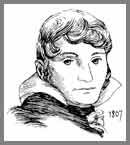
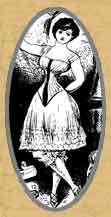
Sources
Drawings of early 18th-century fashions are from Douglas Gorsline, A History of Fashion: A Visual Survey of Costume from Ancient Times (London: Fitzhouse Books, 1953), pp. 134-135.
The wasp-waisted belle was reprinted in David Kunzle’s Fashion and Fetishism: A Social History of the Corset, Tight-Lacing and Other Forms of Body-Sculpture in the West (Totowa, NJ: Rowman and Littlefield, 1982), Plate 38.
Notes
| ↑1 | Paul Kane, Wanderings of an Artist Among the Indians of North America: From Canada to Vancouver’s Island and Oregon through the Hudson’s Bay Company Territory and Back Again (London: Longman, Brown, Green Longmans, and Roberts, 1859), 205. Internet Archive. |
|---|---|
| ↑2 | James G. Swan, The Northwest Coast; or, Three Years’ Residence in Washington Territory (New York: Harper & Brothers, 1857), 167-68. Internet Archive. A brief biography of this remarkably versatile man may be seen at HistoryLink.org, http://www.historylink.org/essays/output.cfm?file_id=5029. |
Experience the Lewis and Clark Trail
The Lewis and Clark Trail Experience—our sister site at lewisandclark.travel—connects the world to people and places on the Lewis and Clark Trail.
Discover More
- The Lewis and Clark Expedition: Day by Day by Gary E. Moulton (University of Nebraska Press, 2018). The story in prose, 14 May 1804–23 September 1806.
- The Lewis and Clark Journals: An American Epic of Discovery (abridged) by Gary E. Moulton (University of Nebraska Press, 2003). Selected journal excerpts, 14 May 1804–23 September 1806.
- The Lewis and Clark Journals. by Gary E. Moulton (University of Nebraska Press, 1983–2001). The complete story in 13 volumes.

